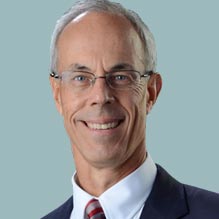Face, Eyebrow, & Necklifts
What is a Facelift?
The loss of youthful contours in the face can be due to a variety of factors, including heredity, gravity, environmental conditions, and stress. A facelift, or rhytidectomy, is a surgical procedure that improves visible signs of aging in the face and neck, such as:
- Sagging in the middle of your face
- Deep creases below the lower eyelids
- Deep creases along the nose extending to the corner of the mouth
- Fat that has fallen or has disappeared
- Loss of skin tone in the lower face that creates jowls
- Loose skin and excess fatty deposits under the chin and jaw can give even a person of normal weight the appearance of a double chin
In general, good candidates for a facelift include:
- Healthy individuals who do not have medical conditions that impair healing
- Non-smokers
- Individuals with a positive outlook and realistic expectations
Rejuvenation procedures typically performed in conjunction with a facelift are brow lift, to correct a sagging or deeply furrowed brow, and eyelid surgery to rejuvenate aging eyes.
What it won’t do: As a restorative surgery, a facelift does not change your fundamental appearance and cannot stop the aging process. A facelift can only be performed surgically; non-surgical rejuvenation treatments cannot achieve the same results, but may help delay the time at which a facelift becomes appropriate and complement the results of surgery.
Consultation and Preparing for Surgery
During your consultation be prepared to discuss:
- Your surgical goals
- Medical conditions, drug allergies, and medical treatments
- Current medications, vitamins, herbal supplements, alcohol, tobacco, and drug use
- Previous surgeries
Your surgeon will also:
- Evaluate your general health status and any pre-existing health conditions or risk factors
- Discuss your facelift options
- Examine and measure your face
- Take photographs
- Recommend a course of treatment
- Discuss likely outcomes of a facelift and any risks or potential complications
- Discuss the type of anesthesia that will be used
Prior to surgery, you may be asked to:
- Get lab testing or a medical evaluation
- Take certain medications or adjust your current medications
- Stop smoking
- Avoid taking aspirin, anti-inflammatory drugs, and herbal supplements as they can increase bleeding
Special instructions you receive will cover:
- What to do on the night before and morning of surgery
- The use of anesthesia during your facelift
- Post-operative care and follow-up
A facelift may be performed in an accredited office-based surgical facility, licensed ambulatory surgical center, or a hospital. Be sure to arrange for someone to drive you to and from surgery and to stay with you for at least the first night following surgery.
Be sure to ask your plastic surgeon questions. It’s very important to understand all aspects of your facelift. It’s natural to feel some anxiety, whether it’s excitement for your anticipated new look or a bit of preoperative stress. Don’t be shy about discussing these feelings with your plastic surgeon.
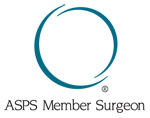
The Procedure
Step 1 – Anesthesia
Medications are administered for your comfort during the surgical procedure. The choices include intravenous sedation and general anesthesia. Your doctor will recommend the best choice for you.
- A variety of other procedures can further enhance the outcome of a facelift. They include:
- Facial implants or fat transfer
- Soft tissue augmentation to recontour the facial structure
- Resurfacing techniques to improve the tone and texture of facial skin
- Wrinkle reduction by injection of fat or fillers
Step 2 – The incision
Depending on the degree of change you’d like to see, your facelift choices include a traditional facelift, limited incision facelift or a neck lift. A traditional facelift incision often begins in the hairline at the temples, continues around the ear and ends in the lower scalp. Fat may be sculpted or redistributed from the face, jowls and neck, and underlying tissue is repositioned, commonly the deeper layers of the face and the muscles are also lifted. Skin is redraped over the uplifted contours and excess skin is trimmed away. A second incision under the chin may be necessary to further improve an aging neck. Sutures or skin adhesives close the incisions.
Traditional Facelift
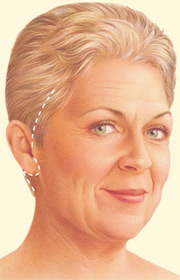
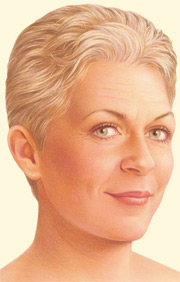
An alternative to a traditional facelift uses shorter incisions at the temples, continuing around the ear and possibly within the lower eyelids or under the upper lip.
Limited Incision
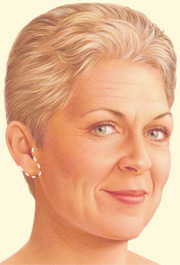
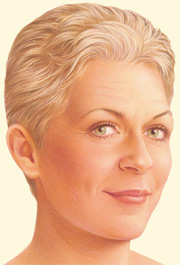
Sagging jowls, loose neck skin and fat accumulation under the chin may be corrected with a neck lift. The neck lift incision often begins in front of the ear lobe and wraps around behind the ear ending in the lower scalp.
Neck Lift
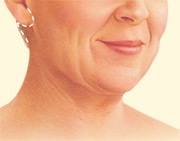
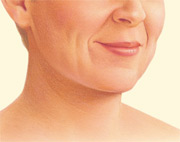
Step 3 – Closing the incisions
Once healed, the incision lines from a facelift are well concealed within the hairline and in the natural contours of the face and ear.
Step 4 – See the results
The visible improvements of a facelift appear as swelling and bruising subside. Your final result should not only restore a more youthful and rested appearance, but also help you feel more confident about yourself.
Risks and Safety
The decision to have a facelift is extremely personal. You will have to decide if the benefits will achieve your goals, and if the risks and potential complications are acceptable. You will be asked to sign consent forms to ensure that you fully understand the procedure and any risks and potential complications.
The risks include:
- Anesthesia risks
- Bleeding
- Infection
- Poor wound healing and skin loss
- Facial nerve injury with weakness
- Temporary or permanent hair loss at the incisions
- Fluid accumulation
- Numbness or other changes in skin sensation
- Persistent pain
- Unfavorable scarring
- Prolonged swelling
- Skin irregularities and discoloration
- Sutures may spontaneously surface through the skin, become visible or produce irritation that require removal
- Unsatisfactory results may include: asymmetry, unsatisfactory surgical scar location and unacceptable visible deformities at the ends of the incisions. (It may be necessary to perform an additional surgery to improve your results)
- Deep vein thrombosis, cardiac and pulmonary complications
These risks and others will be fully discussed prior to your consent. It is important that you address all your questions = directly with your plastic surgeon.
If your surgeon uses fibrin sealants (tissue glue): Fibrin sealants (made from heat-treated human blood components to inactivate virus transmission) are used to hold tissue layers together at surgery and to diminish post-operative bruising following surgery. This product is carefully produced from donor blood plasma screened for hepatitis, syphilis, and human immunodeficiency virus (HIV). Cardiovascular and general surgeons have used fibrin sealants in their procedures for many years. This product is thought to be of help in diminishing surgical bleeding by adhering layers of tissue together.
Recovery After Surgery

When your procedure is completed, a bandage might be placed around your face to minimize swelling and bruising. Thin tubes may be present to drain any excess blood or fluid that may collect under the skin.
You will be given specific instructions that may include how to care for the surgical site and drains, medications to apply or take orally to aid healing and reduce the potential for infection, specific concerns to look for at the surgical site or in your general health, and when to follow up with your plastic surgeon.
Be sure to ask your plastic surgeon specific questions about what you can expect during your individual recovery period.
- Where will I be taken after my surgery is complete?
- What medication will I be given or prescribed after surgery?
- Will I have dressings/bandages after surgery?
- When will they be removed?
- Are stitches removed? When?
- When can I wear make-up?
- When can I resume normal activity and exercise?
- When can I see my stylist for hair color and cut?
Results

It may take a few months for swelling to fully dissipate and for incision lines to mature. Life-long sun protection and a healthy lifestyle will help extend the results of your rejuvenated, more youthful appearance.
As swelling and bruising subside, the visible improvements of a facelift appear. Your final result should not only provide a more youthful and rested appearance, but also help you feel more confident about yourself.
Although good results are expected from your procedure, there is no guarantee. In some situations, it may not be possible to achieve optimal results with a single surgical procedure and another surgery may be necessary.
Following your physician’s instructions is essential to the success of your surgery. It is important that the surgical incisions are not subjected to excessive force, abrasion, or motion during the time of healing. Avoid wearing any clothing that must go over your head. Your doctor will give you specific instructions on how to care for yourself.
Cost
Prices for facelifts can vary. A surgeon’s cost may be based on his or her experience, the type of procedure used, and geographic office location. Many plastic surgeons offer patient financing plans, so be sure to ask.
Cost may include:
- Anesthesia fees
- Hospital or surgical facility costs
- Medical tests
- Post-surgery garments
- Prescriptions for medication
- Surgeon’s fee
Most health insurance does not cover cosmetic surgery or its complications.
Your satisfaction involves more than a fee:
When choosing a plastic surgeon for a facelift, remember that the surgeon’s experience and your comfort with him or her is just as important as the final cost of the surgery.
Plastic surgery involves many choices. The first and most important is selecting an American Society of Plastic Surgeons (ASPS) member you can trust. ASPS member surgeons are board certified by the American Board of Plastic Surgery® (ABPS). ASPS member surgeons meet rigorous standards:
- Graduate from an accredited medical school
- Complete at least six years of surgical training following medical school with a minimum of three years of plastic surgery residency training
- Pass comprehensive oral and written exams
- Be certified by the ABPS or in Canada by The Royal College of Physicians and Surgeons of Canada®
- Complete continuing medical education, including patient safety each year
- Perform surgery in accredited, state-licensed, or Medicare-certified surgical facilities
Do not be confused by other official sounding boards and certifications.
The ABPS is recognized by the American Board of Medical Specialties (ABMS), which has approved medical specialty boards since 1934. There is no ABMS recognized certifying board with “cosmetic surgery” in its name. By choosing a member of The American Society of Plastic Surgeons, you can be assured that you are choosing a qualified, highly trained plastic surgeon who is board-certified by the ABPS or The Royal College of Physicians and Surgeons of Canada.
This procedural information is intended strictly for educational purposes. Only models are depicted in these procedural information pages. It is not intended to make any representations or warranties about the outcome of any procedure. It is not a substitute for a thorough, in-person consultation with a board certified plastic surgeon.
What is a Brow Lift?
.jpg)
As we age, unsightly wrinkle lines may appear on the forehead. Frown lines between the brows can make us look angry or “too serious”. Skin relaxation may cause the eyebrows to drop, hooding our upper eyelids and making us look tired. If you are bothered by these signs of aging in the brow region, a brow lift may be right for you.
A brow lift:
- Reduces the wrinkle lines that develop horizontally across the forehead, as well as those that occur on the bridge of the nose, between the eyes
- Improves frown lines, the vertical creases that develop between the eyebrows
- Raises sagging brows that are hooding the upper eyelids
- Places the eyebrows in an alert and youthful position
Other cosmetic procedures that may be performed with a brow lift include:
- Upper and or lower eyelid tucks
- Facelifting
- Skin resurfacing techniques
Consultation and Preparing for Surgery
During your consultation be prepared to discuss:
- Your goals for your appearance
- Your complete medical history
- Your current medications, vitamins, herbal supplements, alcohol, tobacco, and drug use
Your surgeon will also:
- Evaluate your general health status and any risk factors
- Discuss your options
- Examine and measure different parts of your face
- Take photographs
- Recommend a course of treatment
- Discuss likely outcomes of brow lift surgery and any potential complications
Be sure to ask your plastic surgeon questions. It’s very important to understand all aspects of your procedure. It’s natural to feel some anxiety, whether it’s excitement for your anticipated new look or a bit of pre-treatment stress. Don’t be shy about discussing these feelings with your plastic surgeon.
Prior to surgery, you may be asked to:
- Get lab testing or a medical evaluation
- Take certain medications or adjust your current medications
- Stop smoking
- Avoid taking aspirin, anti-inflammatory drugs, and other supplements as they can increase bleeding
Brow lift surgery should be performed in an accredited surgical facility, licensed ambulatory surgical center, or a hospital. You will need to arrange for another adult to drive you to and from surgery, and to stay with you for at least the first night following surgery.

The Procedure
You will be given medication so that you will be comfortable during the surgical procedures. Your surgeon will suggest either intravenous sedation or general anesthesia. Brow lifts can be performed in different ways. Some surgeons prefer using an endoscope (a thin tube with a camera on the end) and special instruments placed through small incisions made within the hairline. This allows the tissue and muscle beneath the skin to be adjusted, correcting the source of visible creases and furrows in the forehead.
Endoscopic Incision
.jpg)
.jpg)
Coronal Incision
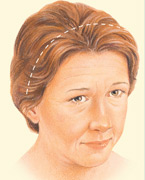
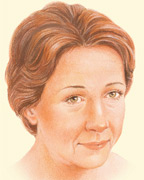
Some surgeons prefer to perform a browlift through what is called a “coronal incision” The coronal incision is created from ear to ear across the top of the head, within the hair-bearing skin.
The forehead skin is then lifted and any muscle adjustment can be made under direct visualization. The resulting scar from a coronal brow lift is well concealed within the hair.
For women with very high foreheads, an incision just at the anterior hairline may be recommended. In this way the brow can be lifted without altering the height of the front hairline. The resulting scar, while somewhat more visible, can often be hidden with bangs.
Results appear gradually as swelling and bruising subside to reveal smoother forehead skin and a more youthful, rested appearance.
Risks and Safety
.jpg)
The decision to have brow lift surgery is extremely personal. You will have to decide if the surgery will achieve your goals and if the risks and potential complications are acceptable. You will be asked to sign consent forms to ensure that you fully understand the procedure and any risks and potential complications.
The risks include:
- Anesthesia risks
- Bleeding
- Loss of hair around the incisions
- Elevated hairline
- Eye irritation or dryness
- Facial asymmetry
- Facial nerve injury with weakness or paralysis
- Fluid accumulation
- Infection
- Numbness or other changes in skin sensation or intense itching
- Pain, which may persist
- Poor wound healing
- Possibility of revision surgery
- Skin discoloration and swelling
- Skin loss
- Unfavorable scarring
- Rare risk of blood clots
These risks and others will be fully discussed prior to your consent. It’s important that you address all your questions directly with your plastic surgeon.
Recovery After Surgery
When your procedure is completed, your forehead may be taped and your head may be loosely wrapped to minimize swelling and bruising. A thin tube may be present to drain any excess blood or fluid that may collect under the skin. You will be given specific instructions that may include how to care for the surgical site and drains, medications to apply or take orally to aid healing and reduce the potential for infection, specific concerns to look for at the surgical site or in your general health, and when to follow up with your plastic surgeon. You should keep your head elevated and perform no vigorous physical activity for as long as your surgeon recommends. Do not use ice or heat on the operated area.
Be sure to ask your plastic surgeon specific questions about what you can expect during your individual recovery period.
- What medication will I need after surgery?
- Will I have dressings/bandages?
- When will they be removed?
- Are stitches removed? When?
- When can I resume normal activity and exercise?
- When do I return for follow-up care?
Initial wound healing may take 10 to 14 days. Sutures or clips will be removed when it is appropriate. You should be ready to return to work and normal activity after two weeks.
Cosmetics can help camouflage any bruising. Even though you will look presentable to the public, you will find that the healing will continue for several weeks, as the swelling dissipates and incision lines refine and fade. It may take several months for your complete recovery.
Following your physician’s instructions is essential to the success of your surgery. It’s important that the surgical incisions are not subjected to excessive force, swelling, abrasion, or motion during the time of healing. Your doctor will give you specific instructions on how to care for yourself.
Results

The results of your brow lift surgery are immediately visible. Over time, post-surgical swelling will resolve and incision lines will fade. Satisfaction with your new image should continue to grow as you recover from surgery. The final results of your surgery will appear over the next few months.
Although good results are expected from your procedure, there is no guarantee.
Life-long sun protection will help to maintain your rejuvenated appearance by minimizing sun damage. A healthy lifestyle will also help extend the results of your rejuvenated, more youthful appearance.
Cost
Prices for a brow lift can vary. Surgeon’s cost may be based on his or her experience, the type of procedure used, and the geographic location of the office. Many plastic surgeons offer patient financing plans, so be sure to ask.
Cost may include:
- Anesthesia fees
- Hospital or surgical facility costs
- Medical tests
- Prescriptions for medication
- Surgeon’s fee
Most health insurance does not cover cosmetic surgery or its complications.
Your satisfaction involves more than a fee:
When choosing a plastic surgeon for a brow lift, remember that the surgeon’s experience and your comfort with him or her is just as important as the final cost of the surgery. Plastic surgery involves many choices. The first and most important is selecting a member of the American Society of Plastic Surgeons (ASPS).
ASPS member surgeons must meet these rigorous standards:
- Board certification by the American Board of Plastic Surgery® (ABPS) or in Canada by The Royal College of Physicians and Surgeons of Canada®
- Completion at least six years of surgical training following medical school with a minimum of three years of rigorous plastic surgery residency training
- Pass comprehensive oral and written exams
- Graduate from an accredited medical school
- Complete continuing medical education, including patient safety each year
- Performing surgery in accredited, state-licensed, or Medicare-certified surgical facilities to assure patient safety
Do not be confused by other official sounding boards and certifications.
The American Board of Plastic Surgery is recognized by is an official member of the American Board of Medical Specialties (ABMS), which has approved medical specialty boards since 1934. There is no ABMS recognized certifying board with “cosmetic surgery” in its name. By selecting a surgeon who is a member of The American Society of Plastic Surgeons, you can be assured that you are choosing a qualified, highly trained plastic surgeon who is board-certified by the ABPS or The Royal College of Physicians and Surgeons of Canada.
This procedural information is intended strictly for educational purposes. Only models are depicted in these procedural information pages. It is not intended to make any representations or warranties about the outcome of any procedure. It is not a substitute for a thorough, in-person consultation with a board certified plastic surgeon.

